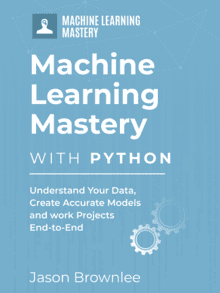Regression is a modeling task that involves predicting a numeric value given an input.
Linear regression is the standard algorithm for regression that assumes a linear relationship between inputs and the target variable. An extension to linear regression invokes adding penalties to the loss function during training that encourages simpler models that have smaller coefficient values. These extensions are referred to as regularized linear regression or penalized linear regression.
Ridge Regression is a popular type of regularized linear regression that includes an L2 penalty. This has the effect of shrinking the coefficients for those input variables that do not contribute much to the prediction task.
In this tutorial, you will discover how to develop and evaluate Ridge Regression models in Python.
After completing this tutorial, you will know:
- Ridge Regression is an extension of linear regression that adds a regularization penalty to the loss function during training.
- How to evaluate a Ridge Regression model and use a final model to make predictions for new data.
- How to configure the Ridge Regression model for a new dataset via grid search and automatically.
Let’s get started.
- Update Oct/2020: Updated code in the grid search procedure to match description.

How to Develop Ridge Regression Models in Python
Photo by Susanne Nilsson, some rights reserved.
Tutorial Overview
This tutorial is divided into three parts; they are:
- Ridge Regression
- Example of Ridge Regression
- Tuning Ridge Hyperparameters
Ridge Regression
Linear regression refers to a model that assumes a linear relationship between input variables and the target variable.
With a single input variable, this relationship is a line, and with higher dimensions, this relationship can be thought of as a hyperplane that connects the input variables to the target variable. The coefficients of the model are found via an optimization process that seeks to minimize the sum squared error between the predictions (yhat) and the expected target values (y).
- loss = sum i=0 to n (y_i – yhat_i)^2
A problem with linear regression is that estimated coefficients of the model can become large, making the model sensitive to inputs and possibly unstable. This is particularly true for problems with few observations (samples) or less samples (n) than input predictors (p) or variables (so-called p >> n problems).
One approach to address the stability of regression models is to change the loss function to include additional costs for a model that has large coefficients. Linear regression models that use these modified loss functions during training are referred to collectively as penalized linear regression.
One popular penalty is to penalize a model based on the sum of the squared coefficient values (beta). This is called an L2 penalty.
- l2_penalty = sum j=0 to p beta_j^2
An L2 penalty minimizes the size of all coefficients, although it prevents any coefficients from being removed from the model by allowing their value to become zero.
The effect of this penalty is that the parameter estimates are only allowed to become large if there is a proportional reduction in SSE. In effect, this method shrinks the estimates towards 0 as the lambda penalty becomes large (these techniques are sometimes called “shrinkage methods”).
— Page 123, Applied Predictive Modeling, 2013.
This penalty can be added to the cost function for linear regression and is referred to as Tikhonov regularization (after the author), or Ridge Regression more generally.
A hyperparameter is used called “lambda” that controls the weighting of the penalty to the loss function. A default value of 1.0 will fully weight the penalty; a value of 0 excludes the penalty. Very small values of lambda, such as 1e-3 or smaller are common.
- ridge_loss = loss + (lambda * l2_penalty)
Now that we are familiar with Ridge penalized regression, let’s look at a worked example.
Example of Ridge Regression
In this section, we will demonstrate how to use the Ridge Regression algorithm.
First, let’s introduce a standard regression dataset. We will use the housing dataset.
The housing dataset is a standard machine learning dataset comprising 506 rows of data with 13 numerical input variables and a numerical target variable.
Using a test harness of repeated stratified 10-fold cross-validation with three repeats, a naive model can achieve a mean absolute error (MAE) of about 6.6. A top-performing model can achieve a MAE on this same test harness of about 1.9. This provides the bounds of expected performance on this dataset.
The dataset involves predicting the house price given details of the house’s suburb in the American city of Boston.
No need to download the dataset; we will download it automatically as part of our worked examples.
The example below downloads and loads the dataset as a Pandas DataFrame and summarizes the shape of the dataset and the first five rows of data.
|
1 2 3 4 5 6 7 8 9 10 |
# load and summarize the housing dataset from pandas import read_csv from matplotlib import pyplot # load dataset url = 'https://raw.githubusercontent.com/jbrownlee/Datasets/master/housing.csv' dataframe = read_csv(url, header=None) # summarize shape print(dataframe.shape) # summarize first few lines print(dataframe.head()) |
Running the example confirms the 506 rows of data and 13 input variables and a single numeric target variable (14 in total). We can also see that all input variables are numeric.
|
1 2 3 4 5 6 7 8 9 |
(506, 14) 0 1 2 3 4 5 ... 8 9 10 11 12 13 0 0.00632 18.0 2.31 0 0.538 6.575 ... 1 296.0 15.3 396.90 4.98 24.0 1 0.02731 0.0 7.07 0 0.469 6.421 ... 2 242.0 17.8 396.90 9.14 21.6 2 0.02729 0.0 7.07 0 0.469 7.185 ... 2 242.0 17.8 392.83 4.03 34.7 3 0.03237 0.0 2.18 0 0.458 6.998 ... 3 222.0 18.7 394.63 2.94 33.4 4 0.06905 0.0 2.18 0 0.458 7.147 ... 3 222.0 18.7 396.90 5.33 36.2 [5 rows x 14 columns] |
The scikit-learn Python machine learning library provides an implementation of the Ridge Regression algorithm via the Ridge class.
Confusingly, the lambda term can be configured via the “alpha” argument when defining the class. The default value is 1.0 or a full penalty.
|
1 2 3 |
... # define model model = Ridge(alpha=1.0) |
We can evaluate the Ridge Regression model on the housing dataset using repeated 10-fold cross-validation and report the average mean absolute error (MAE) on the dataset.
|
1 2 3 4 5 6 7 8 9 10 11 12 13 14 15 16 17 18 19 20 21 22 |
# evaluate an ridge regression model on the dataset from numpy import mean from numpy import std from numpy import absolute from pandas import read_csv from sklearn.model_selection import cross_val_score from sklearn.model_selection import RepeatedKFold from sklearn.linear_model import Ridge # load the dataset url = 'https://raw.githubusercontent.com/jbrownlee/Datasets/master/housing.csv' dataframe = read_csv(url, header=None) data = dataframe.values X, y = data[:, :-1], data[:, -1] # define model model = Ridge(alpha=1.0) # define model evaluation method cv = RepeatedKFold(n_splits=10, n_repeats=3, random_state=1) # evaluate model scores = cross_val_score(model, X, y, scoring='neg_mean_absolute_error', cv=cv, n_jobs=-1) # force scores to be positive scores = absolute(scores) print('Mean MAE: %.3f (%.3f)' % (mean(scores), std(scores))) |
Running the example evaluates the Ridge Regression algorithm on the housing dataset and reports the average MAE across the three repeats of 10-fold cross-validation.
Your specific results may vary given the stochastic nature of the learning algorithm. Consider running the example a few times.
In this case, we can see that the model achieved a MAE of about 3.382.
|
1 |
Mean MAE: 3.382 (0.519) |
We may decide to use the Ridge Regression as our final model and make predictions on new data.
This can be achieved by fitting the model on all available data and calling the predict() function, passing in a new row of data.
We can demonstrate this with a complete example listed below.
|
1 2 3 4 5 6 7 8 9 10 11 12 13 14 15 16 17 18 |
# make a prediction with a ridge regression model on the dataset from pandas import read_csv from sklearn.linear_model import Ridge # load the dataset url = 'https://raw.githubusercontent.com/jbrownlee/Datasets/master/housing.csv' dataframe = read_csv(url, header=None) data = dataframe.values X, y = data[:, :-1], data[:, -1] # define model model = Ridge(alpha=1.0) # fit model model.fit(X, y) # define new data row = [0.00632,18.00,2.310,0,0.5380,6.5750,65.20,4.0900,1,296.0,15.30,396.90,4.98] # make a prediction yhat = model.predict([row]) # summarize prediction print('Predicted: %.3f' % yhat) |
Running the example fits the model and makes a prediction for the new rows of data.
|
1 |
Predicted: 30.253 |
Next, we can look at configuring the model hyperparameters.
Tuning Ridge Hyperparameters
How do we know that the default hyperparameters of alpha=1.0 is appropriate for our dataset?
We don’t.
Instead, it is good practice to test a suite of different configurations and discover what works best for our dataset.
One approach would be to grid search alpha values from perhaps 1e-5 to 100 on a log scale and discover what works best for a dataset. Another approach would be to test values between 0.0 and 1.0 with a grid separation of 0.01. We will try the latter in this case.
The example below demonstrates this using the GridSearchCV class with a grid of values we have defined.
|
1 2 3 4 5 6 7 8 9 10 11 12 13 14 15 16 17 18 19 20 21 22 23 24 25 |
# grid search hyperparameters for ridge regression from numpy import arange from pandas import read_csv from sklearn.model_selection import GridSearchCV from sklearn.model_selection import RepeatedKFold from sklearn.linear_model import Ridge # load the dataset url = 'https://raw.githubusercontent.com/jbrownlee/Datasets/master/housing.csv' dataframe = read_csv(url, header=None) data = dataframe.values X, y = data[:, :-1], data[:, -1] # define model model = Ridge() # define model evaluation method cv = RepeatedKFold(n_splits=10, n_repeats=3, random_state=1) # define grid grid = dict() grid['alpha'] = arange(0, 1, 0.01) # define search search = GridSearchCV(model, grid, scoring='neg_mean_absolute_error', cv=cv, n_jobs=-1) # perform the search results = search.fit(X, y) # summarize print('MAE: %.3f' % results.best_score_) print('Config: %s' % results.best_params_) |
Running the example will evaluate each combination of configurations using repeated cross-validation.
Your specific results may vary given the stochastic nature of the learning algorithm. Try running the example a few times.
In this case, we can see that we achieved slightly better results than the default 3.379 vs. 3.382. Ignore the sign; the library makes the MAE negative for optimization purposes.
We can see that the model assigned an alpha weight of 0.51 to the penalty.
|
1 2 |
MAE: -3.379 Config: {'alpha': 0.51} |
The scikit-learn library also provides a built-in version of the algorithm that automatically finds good hyperparameters via the RidgeCV class.
To use this class, it is fit on the training dataset and used to make a prediction. During the training process, it automatically tunes the hyperparameter values.
By default, the model will only test the alpha values (0.1, 1.0, 10.0). We can change this to a grid of values between 0 and 1 with a separation of 0.01 as we did on the previous example by setting the “alphas” argument.
The example below demonstrates this.
|
1 2 3 4 5 6 7 8 9 10 11 12 13 14 15 16 17 18 |
# use automatically configured the ridge regression algorithm from numpy import arange from pandas import read_csv from sklearn.linear_model import RidgeCV from sklearn.model_selection import RepeatedKFold # load the dataset url = 'https://raw.githubusercontent.com/jbrownlee/Datasets/master/housing.csv' dataframe = read_csv(url, header=None) data = dataframe.values X, y = data[:, :-1], data[:, -1] # define model evaluation method cv = RepeatedKFold(n_splits=10, n_repeats=3, random_state=1) # define model model = RidgeCV(alphas=arange(0, 1, 0.01), cv=cv, scoring='neg_mean_absolute_error') # fit model model.fit(X, y) # summarize chosen configuration print('alpha: %f' % model.alpha_) |
Running the example fits the model and discovers the hyperparameters that give the best results using cross-validation.
Your specific results may vary given the stochastic nature of the learning algorithm. Try running the example a few times.
In this case, we can see that the model chose the identical hyperparameter of alpha=0.51 that we found via our manual grid search.
|
1 |
alpha: 0.510000 |
Further Reading
This section provides more resources on the topic if you are looking to go deeper.
Books
APIs
Articles
Summary
In this tutorial, you discovered how to develop and evaluate Ridge Regression models in Python.
Specifically, you learned:
- Ridge Regression is an extension of linear regression that adds a regularization penalty to the loss function during training.
- How to evaluate a Ridge Regression model and use a final model to make predictions for new data.
- How to configure the Ridge Regression model for a new dataset via grid search and automatically.
Do you have any questions?
Ask your questions in the comments below and I will do my best to answer.








Hi Jason,
Another simple, to-the-point article as always.
There is a sentence under the Ridge Regression section:
“This is particularly true for problems with few observations (samples) or more samples (n) than input predictors (p) or variables (so-called p >> n problems).”
Unless I am wrong, I believe this should have instead read “…less samples (n) than input predictors (p)…”?
Thanks! Fixed.
Hi Jason, I also noticed this error in the your tutorial for Lasso and Elastic Net regression.
Thanks.
L2 penalty looks different from L2 regularization. Are they really different? What is the difference?
Same thing. L2 of model weights/coefficient added to loss.
In neural nets we call it weight decay:
https://machinelearningmastery.com/weight-regularization-to-reduce-overfitting-of-deep-learning-models/
Hi,
if :
grid[‘alpha’] = [1e-5, 1e-4, 1e-3, 1e-2, 1e-1, 0.0, 1.0, 10.0, 100.0]
then :
Config: {‘alpha’: 0.51}
is not possible as 0.51 is not in [1e-5, 1e-4, 1e-3, 1e-2, 1e-1, 0.0, 1.0, 10.0, 100.0]
Thanks, looks like I pasted the wrong version of the code in the tutorial. Fixed!
Hi, is there more information for kernalised ridge regression?
Yes, right here:
https://scikit-learn.org/stable/modules/generated/sklearn.kernel_ridge.KernelRidge.html
hello, Thank you for this best tutorial for the topic, that I found:)
I have a question.
How to tune further the parameters in Ridge? My prediction is somehow ‘shifted’ in relation to ground truth data. Do you think that the reason is not-normalized data?
Thx,
Perhaps some of these suggestions will help:
https://machinelearningmastery.com/machine-learning-performance-improvement-cheat-sheet/
Is MAE in % here?
MAE (mean absolute error) is the average error, it not a percentage.
So, how do you get it to output the end equation for you once it has fit the model appropriately?
We generally do not, e.g. this is applied ML, we want a model for use in software, not an equation.
Nevertheless, I suspect you can retrieve the coefficients from the fit model and determine how they are used to make predictions by reading the open-source code library.
Why Ridge with Tensorflow or Keras give me a different result with sklearn at high alpha(2000)?
make_regression Dataset
X, y, coef = make_regression(
n_samples=100,
n_features=n_features,
n_informative=n_features,
n_targets=1,
noise=0,
effective_rank=1000,
coef=True,
)
Perhaps this will help:
https://machinelearningmastery.com/faq/single-faq/why-do-i-get-different-results-each-time-i-run-the-code
Thanks for doing this. I ran same dataset for LinearRegression and got a better prediction on same defined new data, why?
Perhaps linear regression is better suited to your dataset.
Hi I just have a question about the data you applied Ridge Regression to. Was it normalized to begin with? If not, why did you not normalize the data? Thanks!
Ridge regression do not necessarily need to normalize. But usually normalization provide a more stable result.